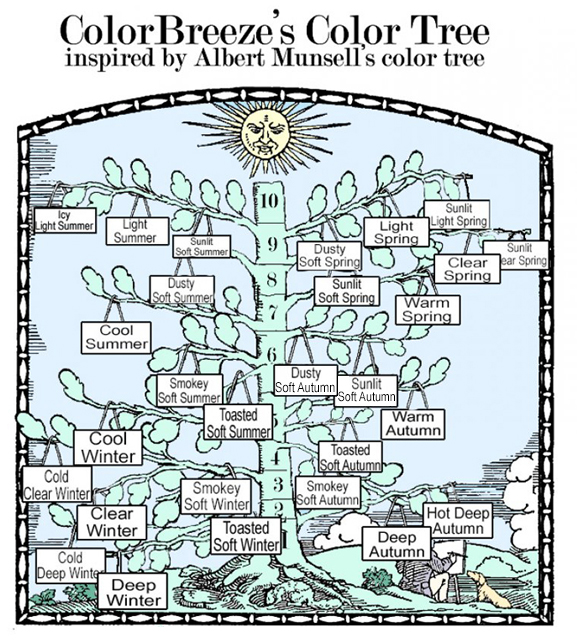The ColorBreeze System
Before I talk about the ColorBreeze system, I want to go back to Albert Munsell's teachings. Some of you may be aware of artist Albert Munsell's Color Tree, created over 100 years ago. Many industries, including most color analysis systems, still follow his theory of color, and ColorBreeze is no exception.
I found this tree helpful in my own understanding of the color seasons. Notice where specific colors sit on his tree. Yellow is at the top since it is lighter in value than blue, which is at the bottom. Pure yellow-based colors, like Springs, are always lighter in value than pure blue-based colors, like Winters.
Warm colors are on the right; cool colors are on the left. And all the variations of these qualities inserted in various spots among the branches.

Since I love to do makeovers, I did one on Munsell's tree! This one is for The ColorBreeze System, the full complete theory, about which I will explain further later on.
See my ColorBreeze version below.
Note: my version does not claim to follow Munsell's theory exactly. While Munsell refers to specific colors, I refer to specific seasons. As you know, seasons are a mix of all types of colors, values, and chroma. But with regards to Munsell's three traits of color - chroma, value, and color- I created a tree that best represents where I feel each season would sit within that tree.

Back to how I developed the ColorBreeze System
My journey through color analysis started with four seasons. As time went by, I studied many people and many color systems. I would follow the expanded systems that I felt were logical and whose categories could be visually identified in people.
Because theory is great, but if you can't identify it in a person, it's useless.
And yet, seeing different categories of coloring in people is great, but there must be a type of logical theory behind it, too. (If there is a "Deep" cool season, there must be a "Deep" Warm Season. And there is. This kind of logic is what I need to see).
I followed the four seasons, then the 12 for a long time. There was a jump to a system with 4 more seasons I followed, but due to legal reasons (despite asking whether the creator of it was ok with me including it my trainings to give her credit, her lawyers want nothing of it mentioned). so I wont. But just know that additional soft seaons were added to the 12 seasons. This meant that there was a soft season in both Springs and Winters, which was totally new and helped identify more people. But I identified additional versions of each of the soft seasons, and then, eventually more Deeps, Lights, and Clears! (see this is why it's called master level learning).
If you are truly obsessed with color analysis and want to learn about the advanced theories, you can always take my ColorBeeze Academy training.
But for everyone else, I will give an overview of what ColorBreeze is and why it's so advanced.
My system builds upon the previous systems I used even further. 12 additional seasons were identified, and there is sound logic behind it. This color theory follows Albert Munsell's approach and his color tree even more thoroughly than any other system out there. (fyi: this is the reason for all of my tree imagery! Plus, I love trees).
In a nutshell:
As my original ColorBreeze identified a warmer and a cooler version of each soft season, I also identified warmer and cooler versions of:
Both Light seasons: Light Summer and Light Spring;
Both Clear seasons: Clear Spring and Clear Winter;
Both Deep seasons: Deep Winter and Deep Autumn.
This brings the total seasons to 28! This ensures that it will offer even more options for people to find their exact right season.
The new seasons are:
Icy Light Summer - All cool undertones; little-to-no visible warmth; does not flow into Spring.
Sunlit Light Spring - All warm undertones; little-to-no visible coolness; does not flow into Summer.
Sunlit Clear Spring - All warm undertones; little-to-no visible coolness; does not flow into Winter.
Cold Clear Winter - All cool undertones; little-to-no visible warmth; does not flow into Spring.
Hot Deep Autumn - All warm undertones; little-to-no visible coolness; does not flow into Winter.
Cold Deep Winter - All cool undertones; little-to-no visible warmth; does not flow into Autumn.
Every one of my 28 seasons can be found here with a quick summary of its qualities.
In the latest edition of my "Color Revival" book, I introduce the concept of the ColorBreeze Complete. I have created mini-eBooks that give more information about each season. I have an mini-ebook for each season. However, I am also in the process of creating new expanded ebook versions (about halfway done) that goes into even further depth.
Admittedly, there are going to be fewer people who fit into these new categories, but they exist, I promise! I've seen them. You will, too, once you start studying color analysis in-depth.
If you felt ok being one of the original Light, Clear, or Deep seasons, but there was something just a little off, you might be one too!
Note: I created some bonus material for those who bought my Face Flash Cards and wanted to learn about finding more seasons. You can visit it here (even if you haven't bought my cards).
For those who are interested in training in-depth or want to be a ColorBreeze analyst, you can do so by taking ColorBreeze Academy training (sign up for my newsletter for updates about it).
Return to Home page



